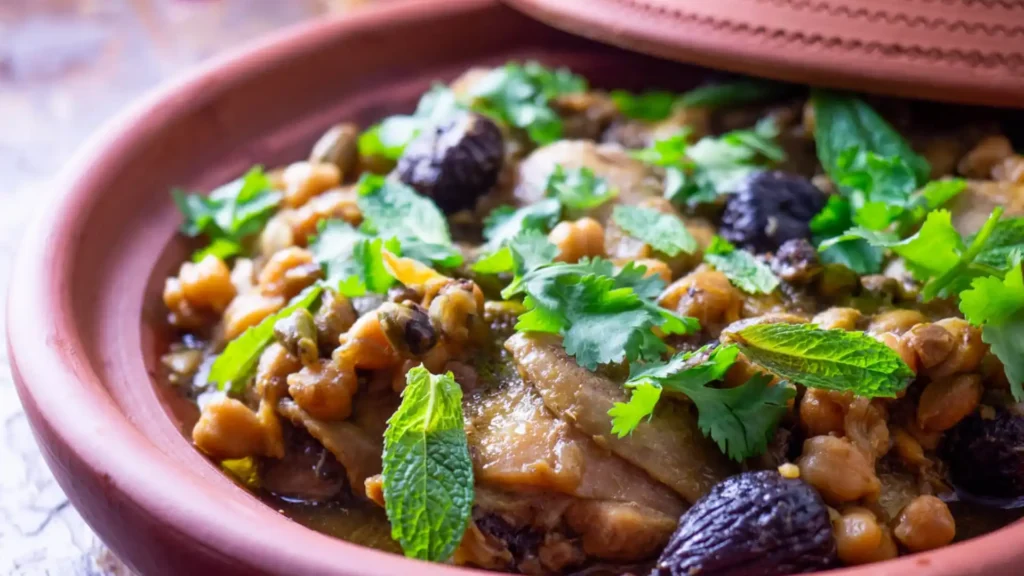Moroccan Tagine, recipe ingredients, cooking, history and more
A Moroccan Tagine is a traditional North African dish that is typically made with chicken or lamb, vegetables, and spices. The dish is cooked in a Tagine, which is a special type of earthenware pot that has a conical lid. This allows the steam to circulate and cook the food evenly. Experience the real Moroccan cuisine Browse our tours and enjoy the included food service to experience real Moroccan traditional meals Browse Now Traveling to Morocco or discovering cities in the Sahara desert, and wondering what food you’ll eat while spending your vacation in Morocco? Imagining what Moroccan cuisine will taste like? You don’t have to worry for the best places to visit in Morocco since every place in the whole country has a culinary background. Moroccan food is regarded as among the best in the world, featuring a wide variety of traditional dishes that draw heavily on the cuisines of the Amazigh, Romans, Africans, Arabs, French, and Spanish. This rich combination of different cultures makes Morocco’s cuisine so versatile. Once you ride and venture into a tour of Marrakech, Meknes, or Fes, which are one of the best cities in Morocco, you will find an unlimited choice of Moroccan street food; you can find both traditional street food and the new school of street food that you can find in almost any street of any Moroccan city. Couscous, Pastilla, or roasted lamb are one of Morocco’s most famous dishes that fascinate people from around the globe. But the traditional Moroccan tagine remains the most iconic national dish. Let’s first picture you what is a tagine: Traditional Moroccan chicken tagine A tagine is a two-piece, conical-shaped earthenware clay pot used in Berber cuisine. The tagine’s design is extremely clever and useful. The steam trapped in the fluted cone on top of the covered pot condenses as it cooks over a heat source, initially hot charcoal, and drops moisture back down to the stewing dish. Only a small portion of water is required to cook the dish. The ingredients tenderize and caramelize evenly, and the natural flavors come through. Harun al Rashid, a leader of the Islamic caliphate in the late 8th century, is often cited as the tagine’s inventor. According to historians, the tagine was mentioned in a compilation of tales from the 9th century called One Thousand and One Nights. According to some food historians, the Roman Empire, which used portable ovens with a shape resembling the tagine, had an even greater impact on the development of the tagine. The tagine was primarily utilized by North African nomads who cooked over an open fire. They could use less desirable and tougher meat to make a tasty stew because the tagine tenderizes it. Moroccan Tagines are traditionally made of clay. The Tagine can also be glazed and painted. It can also go untreated. For cooking, you’ll need a simple Tagine. The patterns aren’t required. If you have the chance to find a genuine Moroccan Tagine, soak it in water overnight. You lower the chance of cracking in this manner. Your Tagines will taste better every time because unglazed cookware absorbs spices and oils. A very thick and sturdy bottom is a must-have when selecting a tagine. It will unavoidably crack if not. Over blazing coals, Moroccans have traditionally prepared their Tagines. It is favorable to have a flame-spreader if your stove is gas. Use a Tagine with a thick bottom and extreme caution if you have a glass-ceramic stove. What to do when you cook a Tagine? Stewing mainly, whether it’s chicken, meat, fish, or vegetables. Small bits of meat are braise-cooked at a barely perceptible boil. Sometimes the meat is first crisp-fried before being braised. Stew differs from other dishes in that it is typically served with a sauce created from the cooking liquid. Water, broth, or even wine may be used as the liquid. The liquid’s ability to swiftly and evenly disperse heat is a benefit. Its temperature is simple to modify to the cook’s preferences, and it can pick up the flavor and transfer it, producing a sauce. However, unlike oil, liquid cannot reach a temperature high enough to impart to meat the flavor and aroma of roasted meat. That is why meat is frequently roasted before stewing. This process prevents the meat from being overcooked. One Tagine, unlimited options! Usually, the more expensive and challenging cuts of beef are used. These meats will melt on your tongue after a lengthy stew. Lamb can sit about all day in a tagine. You hardly have to exert any effort at all! Put the lamb, spices, and liquid in a tagine in the morning, and cook over very low heat all day, and remember, cooking the perfect tagine is much about patience and trusting the slow cooking process. The best cuts for this are lamb necks or shanks. Add your choice of herbs, spices, veggies, or olives 30 minutes before the cooking is finished. Fish should only be cooked for 40 minutes at most, while chicken should only be cooked for about an hour and a half and sometimes just one hour. Preserved lemons are the secret to making any tagine the perfect tagine. Lemons that have been salted are still another essential component in many Tagine recipes. These lemons are essentially leavened in a salt solution. Spices are occasionally added to the solution. Although we don’t think any of this is genuinely luxurious, it makes the whole difference and will add extra taste to your dish; spices are not required. Lemons are pretty simple to prepare at home. The month-long wait before using homemade products is their main drawback. These lemons combine well with chicken and olives tagines, slow-cooked meat tagine with caramelized onions, and much more… Before diving into some of the best Moroccan Tagine dishes, let’s keep looking at this amazing culinary tool to really appreciate and understand its mechanism, therefore mastering the cooking of an authentic Moroccan tagine. Because of its peculiar cover, we


